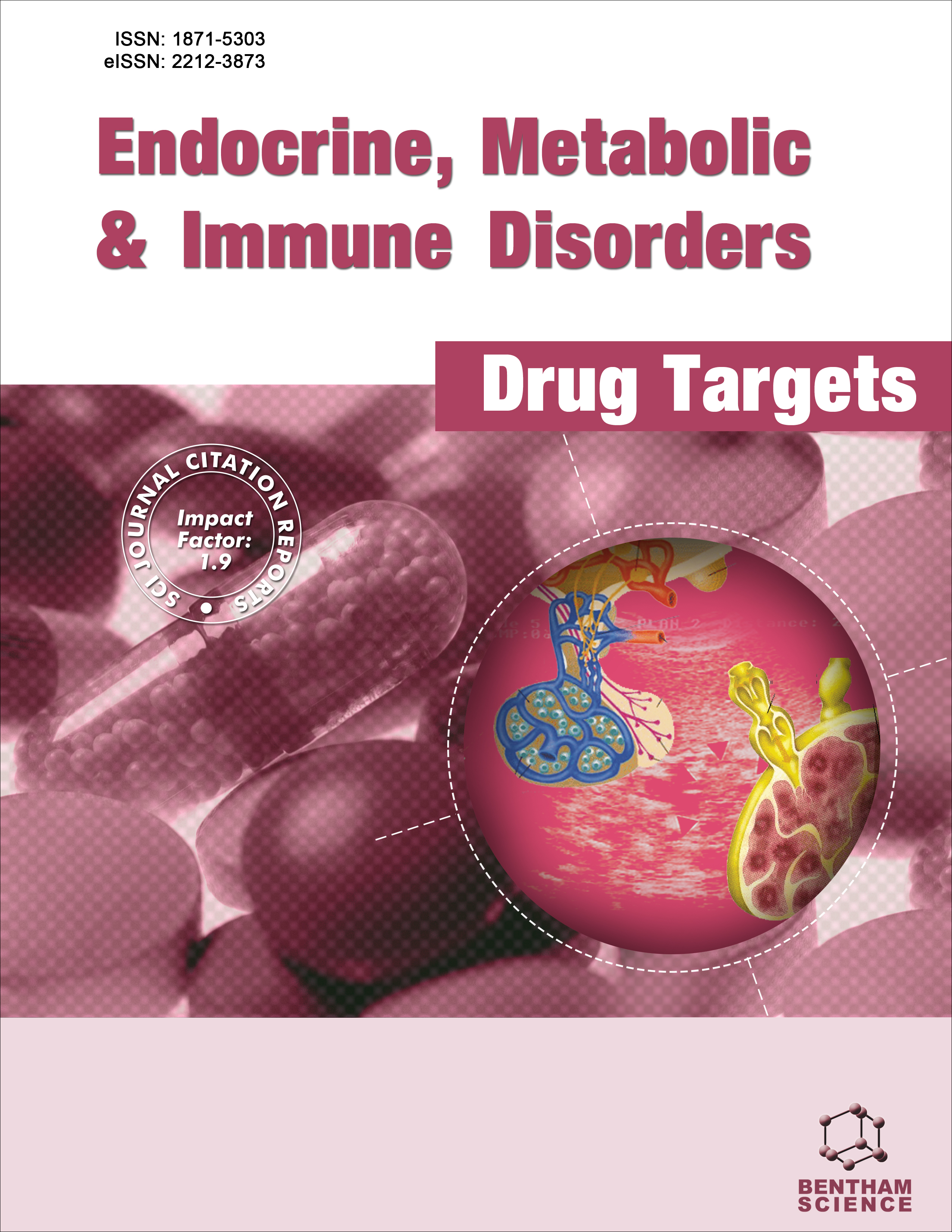- Home
- A-Z Publications
- Endocrine, Metabolic & Immune Disorders-Drug Targets (Formerly Current Drug Targets - Immune, Endocrine & Metabolic Disorders)
- Previous Issues
- Volume 22, Issue 9, 2022
Endocrine, Metabolic & Immune Disorders-Drug Targets (Formerly Current Drug Targets - Immune, Endocrine & Metabolic Disorders) - Volume 22, Issue 9, 2022
Volume 22, Issue 9, 2022
-
-
Searching for a Link between Bone Decay and Diabetes Type 2
More LessThe current commentary describes the possible existing link between metabolic diseases such as diabetes type 2 and the degenerative patterns of bones via the molecular mechanism that inhibits the mesenchymal stem cells’ differentiation into osteoblasts and osteocytes.
-
-
-
Advancement in Nanoformulations for the Management of Diabetic Wound Healing
More LessAuthors: Shailendra S. Bhadauria and Rishabha MalviyaPeople with diabetes have a very slow tendency for wound healing. Wound healing is a vast process where several factors inhibit the sequence of healing. Nano-formulations play a major role in acute and chronic wound healing. The present manuscript aims to discuss the role of nanoformulations for diabetic wound healing treatment. Diabetes is a common disease that has harmful consequences which over the ti Read More
-
-
-
BPS and BPF are as Carcinogenic as BPA and are Not Viable Alternatives for its Replacement
More LessAuthors: Felipe S. Edaes and Cleide Barbieri de SouzaBackground: Plastic polymers are omnipresent, and life without them is virtually impossible. Despite the advantages provided by the material, conventional plastic also has harmful effects on the environment and human health. Plastics release microplastics and compounds, such as BPA, which is a xenoestrogen and once absorbed by the body, have an affinity for estrogen receptors α and β, acting as an agonist on human Read More
-
-
-
Vaccine Efficacy Denial: A Growing Concern Affecting Modern Science, and Impacting Public Health
More LessThe discovery of the vaccination technique was revealed by Edward Jenner in 1796, which represented the first scientific attempt to control an infectious disease by vaccines, followed by other important studies carried out by Pasteur and Koch, and Sabin, who developed the first technique to attenuate the virus. In recent decades, numerous scholars have begun to create dangerous theories against the effectiveness of vacc Read More
-
-
-
Effects of Dapagliflozin on Adipose and Liver Fatty Acid Composition and mRNA Expression Involved in Lipid Metabolism in High-Fat-Fed Rats
More LessBackground: SGLT2 inhibitor enhances not only glucose excretion but also fatty acid utilization. Those facts suggest that SGLT2 inhibitor affects fat accumulation and lipid storage. Objective: In the present study, we evaluated the effects of dapagliflozin on fatty acid composition and gene expression involved in fatty acid metabolism in rat adipose and liver tissues. Methods: We administered 1 mg/kg/day dapagliflozin for 7 Read More
-
-
-
Growth Hormone/Insulin-like Growth Factor 1 Axis Associated with Modifier Factors in Children with Sickle Cell Anemia
More LessBackground: Sickle cell anemia is a disease that develops episodes of acute pain and multiple organ dysfunction that can affect the growth hormone/insulin-like growth factor 1 (GH/IGF-1) axis. The severity of sickle cell anemia is influenced by modifying factors, such as levels of fetal hemoglobin (HbF), the co-inheritance of alphathalassemia, or treatment with hydroxyurea. Methods: This cross-sectional study in childre Read More
-
-
-
Therapeutic Effects and Mechanism of Liraglutide in Rats with Type 2 Diabetes and Metabolic-associated Fatty Liver Disease
More LessAuthors: Xuanye Zhao, Yaoji Liu, Jingjin Liu and jie QinBackground: SREBP-1c/Insig/SCAP acts as a lipid de novo synthesis pathway, and its factors are highly expressed in the endoplasmic reticulum. At present, this pathway has become a research hotspot in the development of metabolic-associated fatty liver disease. However, there are few studies on how various factors in this pathway change after endoplasmic reticulum stress; in particular, the role of the insulin-inducing g Read More
-
-
-
Cardiorenal Syndrome Triggered by Slowly Progressive Drugs Toxicity-Induced Renal Failure along with Minimal Mitral Disease: A Case Report
More LessAuthors: Carlo Caiati, Adriana Argentiero, Stefano Favale and Mario E. LeperaBackground: We report the case of a 93-year-old patient with normal left ventricular function and severe mitral annulus calcification, with mild mitral steno-insufficiency. Case Presentation: She had developed creeping drugs-induced renal toxicity that is generally totally overlooked, due mainly to statins, a proton pump inhibitor, and aspirin. The Na and fluid retention, along with hypertension that ensued, although not sev Read More
-
Volumes & issues
-
Volume 25 (2025)
-
Volume 24 (2024)
-
Volume 23 (2023)
-
Volume 22 (2022)
-
Volume 21 (2021)
-
Volume 20 (2020)
-
Volume 19 (2019)
-
Volume 18 (2018)
-
Volume 17 (2017)
-
Volume 16 (2016)
-
Volume 15 (2015)
-
Volume 14 (2014)
-
Volume 13 (2013)
-
Volume 12 (2012)
-
Volume 11 (2011)
-
Volume 10 (2010)
-
Volume 9 (2009)
-
Volume 8 (2008)
-
Volume 7 (2007)
-
Volume 6 (2006)
Most Read This Month
Article
content/journals/emiddt
Journal
10
5
false
en


